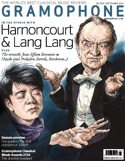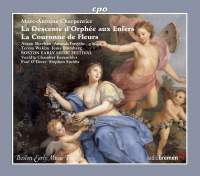Texte paru dans: / Appeared in:
*

GRAMOPHONE (09/2014)
Pour s'abonner /
Subscription information
CPO 7778762

Code-barres / Barcode : 0761203787623 (ID436)
Reviewer:
Julie
Anne Sadie
The musicians of the Boston Early Music Festival first performed this charming pair of pastorales in 2011. They date very closely, from 1685-86. From the names annotated in the manuscripts we know that parts were composed with musicians in the employ of the Duchesse de Guise in mind; Charpentier himself was to sing the part of the shepherd Forestan in La couronne de fleurs. Only La descente d’Orphée aux enfers has been previously recorded, by Les Arts Florissants in 1995.
La descente d’Orphée, based on Ovid, is a two-act operatic fragment, possibly never completed. La couronne de fleurs is a panegyric to Louis XIV, apparently composed to celebrate the Truce of Ratisbon. Both call for similar solo vocal and choral resources. As in Charpentier’s day, many of the singers take multiple roles in both works, one present exception being the tenor Aaron Sheehan, who sings the role of Orpheus, a finely nuanced interpretation, if less overtly dramatic than Paul Agnew’s 1995 performance. Amanda Forsythe is a charming Euridice and Rosélie, Teresa Wakim a beautifully styled Flore, and Dorothee Mields a compelling Amaranthe and Proserpine. Among the male cameo roles, Jesse Blumberg’s Pan, Jason McStoots’s Forestan and Douglas Williams’s Sylvandre and obliging Pluton deserve praise. The soprano duet (tr 19) and male-voice trio (trs 28 and 30) in La descente d’Orphée stand out among the choral contributions in both works.
Charpentier’s stated instrumental
forces are modest: two treble parts, two bass viols and continuo (a third bass
viol and harpsichord) for the opera and, more specifically, two treble viols and
continuo for La couronne de fleurs. Both works include cheerful ouvertures and
diverting entrées (dances), prompting O’Dette and Stubbs to employ larger and
more varied resources to enhance their characterisation, though the dramatic
action is accompanied mainly by the continuo instruments. The exceptions are the
Prelude to Act 2 scene 2 and the series of ‘Airs d’Orphée’ in La descente
d’Orphée, which, unusually, rely upon the artfulness of the two bass viol
players, Laura Jeppeson and Cristel Thielmann.
Bravo!
Cliquez l'un ou l'autre
bouton pour découvrir bien d'autres critiques de CD
Click either button for many other reviews


